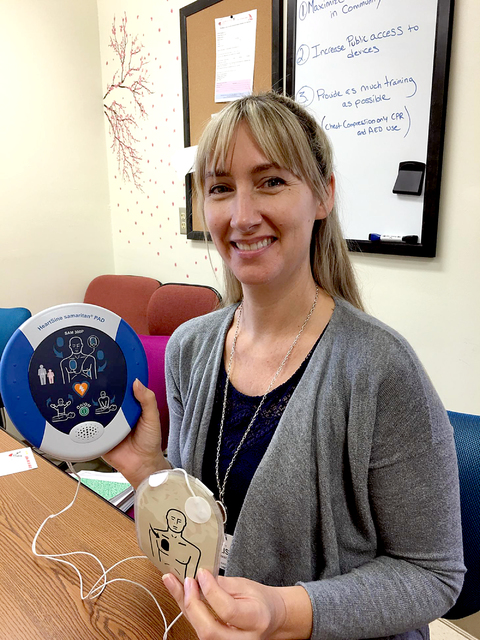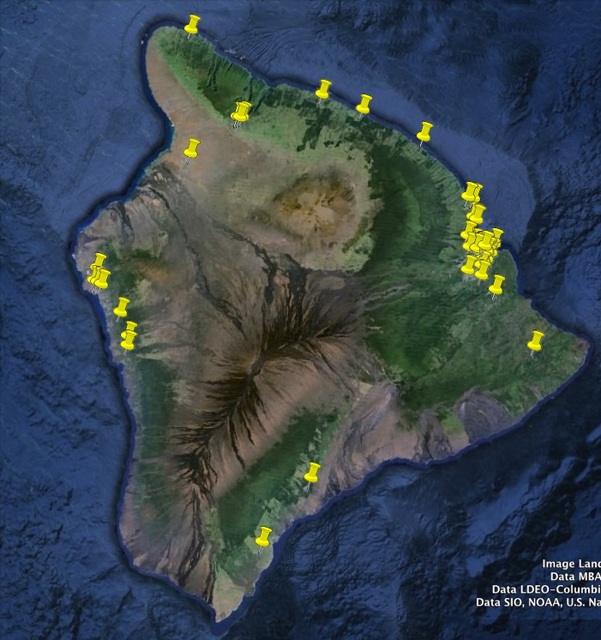Campaign aims to improve cardiac arrest survival rates
Over the last two years, Hawaii Island’s survival rate for people experiencing cardiac arrest in front of bystanders went from 4 percent to 6.8 percent.
ADVERTISING
The jump appears to be the result of efforts by the Hawaii Fire Department to train people in important life-saving techniques including performing chest compressions and the use of automated external defibrillators (AEDs), according to Chris Honda, captain of the department’s Emergency Medical Services Bureau.
“We’re still getting this off the ground, but we’ve already seen that it’s having an effect,” he said Thursday. “Recently, we gave a class at the Walk With a Doc program, and two weeks later one of the participants actually had to use it, and he actually ended up saving his friend’s life.”
Firefighters are currently focusing on training high school seniors, and have so far held classes in about 75 percent of Hawaii Island’s schools. The also provide classes for area businesses and organizations.
Each year, there are about 250 cardiac arrests on the Big Island, and when they happen, the chances of survival are slim, explained Lance Uchida, fire department batallion chief.
“It’s serious,” he said. “At that point, there’s really only two things that can save you: chest compressions and electricity.”
When the heart stops beating, oxygenated blood must be pushed to the brain to keep it alive until emergency services arrive, so having a population educated about CPR is an incredibly important part of improving survivability rates, Uchida said.
With that goal in mind, the Hilo Medical Center Foundation, in conjunction with partners including the fire department, the County of Hawaii, Hilo Medical Center, KTA Super Stores, the Hawaii Island Chamber of Commerce, and more, will officially kick off on Feb. 24 the “Be a Lifesaver Hawaii” campaign.
Including purchasing signage, flyers and other informational outreach efforts, the program will bring new equipment to the island, including AEDs, which can be used in emergency situations to effectively “jumpstart” a person’s heart if they are experiencing cardiac arrest, said Lisa Rantz, executive director of the HMC Foundation.
“We recently got 10 of them delivered, and we’re looking now to see where they can best be used.”
Last spring, firefighters began documenting where AEDs are located around the island to help them figure out where more are needed. The county, not including private businesses and locations, currently has 60 of the devices at various county facilities, including gymnasiums, recreation areas, baseyards, wastewater treatment plants and more.
The new signage will help people to know where the AEDs are located when an emergency strikes, Rantz said.
“Often, they’ll be right there, but people don’t know what they are or what they’re for,” she said.
The machines are simple to operate, with a recorded voice giving instructions on how to prepare and affix the device to a person’s chest. The machines can monitor someone’s condition and deliver shocks when needed.
Rantz added that the Be a Lifesaver campaign will also look into the possibility of becoming a PulsePoint community, which is based around a mobile app that helps direct people with CPR training to emergency situations in their immediate area.
When a person collapses from cardiac arrest and time is of the essence, bystanders can use the app to report the event, and people who have it installed on their phones and who are trained in CPR methods will receive an alert with a GPS map to the location, so they can provide aid until emergency services arrive.
That’s an especially important service for a place like Hawaii Island, where first responders wrestle with vast geographic distances to travel in emergency situations, Uchida said.
Response times in East Hawaii can average between eight and nine minutes, he said. Places with much shorter response times see far greater survival rates. For instance, in Seattle, where response times are between two and three minutes, cardiac arrest survival rates can be as high as 60 percent.
While such a high number may not be a realistic goal for Hawaii Island, there is plenty of room to improve, Uchida said.
“I think we can get to 10 percent, and I’d be happy with that. We can continue to grow and get better. And when you’re talking about this, you’re not just talking about percentage points. You’re talking about saving lives,” he said.
The Hilo Medical Center Foundation will officially launch Be a Lifesaver on Feb. 24 at a meeting of the Hawaii Island Chamber of Commerce. Attendees will have the opportunity to witness CPR and AED demonstrations, and learn how they can help with the continued campaign.
For more information, visit the foundation at hilomedicalcenterfoundation.org or call 932-3636.
Email Colin M. Stewart at cstewart@hawaiitribune -herald.com.




